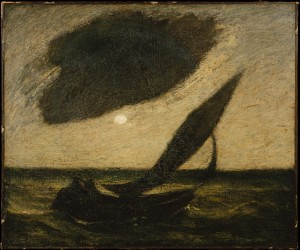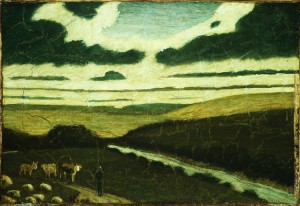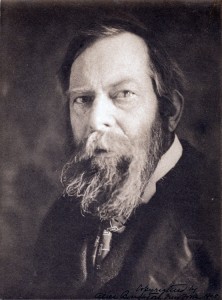Albert Pinkham Ryder: 100 Years
March 28, 2017
Today, March 28, marks 100 years since the death of American artist Albert Pinkham Ryder (1847-1917). Ryder is considered one of the most original of American painters. He is best known for his brooding night scenes of the sea and dreamlike landscapes. Many of his paintings are based on historical, literary, and religious texts. Ryder conceived simple, bold designs, and he often used dark and pale tones in dramatic contrast. He laid paint on thickly, working on each painting for a long time, creating layers of textured color.

Under a Cloud by Albert Pinkham Ryder. Credit: Under a Cloud (1900), oil on canvas by Albert Pinkham Ryder; Metropolitan Museum of Art
Ryder was born on March 19, 1847, in New Bedford, Massachusetts, a town deeply rooted in the whaling industry of the time. As a youth, Ryder witnessed the constant coming and going of whaling ships, all while hearing harrowing tales of whaling itself. His images of ships on turbulent, nighttime seas serve almost as bleak warnings. At the same time, his landscapes—often with the sea in the background—show a romantic vision of life on land. Regardless of the subject, darkness looms and often dominates Ryder’s creative and strikingly original paintings.
Ryder had already produced landscapes by the time he moved to New York City in 1870. His maritime fascinations continued in New York, where he studied the play of moonlight on ships sailing the Hudson River. Romantic and independent by nature, Ryder worked in seclusion and was largely self-taught. Ryder did have contact with other artists, however, and he traveled to Europe to study the natural scenes of the French Barbizon and Dutch Hague schools—both strong influences on his later works. Ryder’s imaginative style, which often approaches abstract and modernist design, won critical praise and influenced many other painters.

Landscape by Albert Pinkham Ryder. Credit: Landscape (1897–98), oil on canvas by Albert Pinkham Ryder; Metropolitan Museum of Art
Ryder exhibited paintings from the 1870’s into the early 1900’s, including a well-received showing at New York City’s famous Armory Show in 1913. Ryder’s health began to fail soon after the Armory Show, and he died on March 28, 1917. A memorial exhibition of his work was held the next year at the Metropolitan Museum of Art in New York City, where Ryder’s paintings are still seen today.



